Hand-arm vibration is a vibration that moves into the worker’s hands and arms through the palms and fingers.
This occurs when someone is working with or holding:
- hand-held power tools (for example, sanders, jackhammers, rock drills, etc.)
- hand-guided equipment (for example, lawnmowers)
- materials being processed by machines (for example, using a pedestal grinder)
The risk of injury due to hand-arm vibration depends on the frequency and magnitude (level) of the vibration, and the length of time a person is exposed to vibration.

Health risks
Workers who are regularly exposed to hand-arm vibration can develop damage to the soft tissues of the fingers, hands, and arms. This causes symptoms that together are known as hand-arm vibration syndrome (HAVS), which is an occupational illness.
HAVS:
- is a range of permanent injuries to one’s fingers, hands and arms that includes damage to the vascular (or circulatory) system (for example, blood vessels), nervous system and musculoskeletal system
- symptoms may come and go over time however, with repeated and continued exposure to vibration, symptoms may become permanent
- symptoms generally occur after exposure to vibration over a few years, however symptoms can occur after only a few months
- is irreversible and there is no effective treatment or cure
( Read more: Hand and Finger Injury Risks in Oil and Gas Industry )
Vascular system
One symptom of HAVS that is present in the vascular system is episodes of whitening or blanching of the fingers. This symptom is sometimes called “Raynaud’s phenomenon of occupational origin” or “vibration-induced white finger.”
Vibration can damage small blood vessels and temporarily reduce blood circulation, making fingers turn white. This usually happens when the hands or body become cold or wet.
As blood flow returns to the fingers, they will turn red and are often painful. During a blanching attack, the worker can experience a loss of touch sensation and manipulative dexterity.
The severity of these attacks can be described using a 5-stage system called the Stockholm Workshop Classification System for Vibration-Induced White Finger. The stages are:
- 0 – no attacks
- 1 – mild: occasional attacks affecting only the tips of one or more fingers
- 2 – moderate: occasional attacks affecting the end and middle of one or more fingers
- 3 – severe: frequent attacks affecting all parts of most fingers
- 4 – very severe: stage 3 symptoms, with trophic skin changes (changes in the skin resulting from interruption of nerve supply) in the fingertips
Workers exposed to hand-arm vibration can also develop vascular symptoms in the feet, including developing vibration-induced white feet. Vibration-induced white feet can also occur if the worker is exposed to the vibration that travels through the feet.
( E-Books: Managing Noise and Vibration at Work )
Nervous system
Tingling and numbness in fingers and hands can be a symptom of HAVS. Continued exposure to vibration can worsen these symptoms and result in a reduced sense of touch and temperature, as well as impaired manual dexterity.
Exposure to hand-arm vibration can also increase a worker’s risk of developing carpal tunnel syndrome. Carpal tunnel syndrome is a condition in which a nerve passing through the wrist is compressed by inflammation (swelling) of other tissues.
Symptoms include tingling, numbness, pain, and weakness in the hand that can interfere with work activities and daily tasks. The use of vibrating tools in combination with repetitive movements, forceful gripping, and awkward postures may increase the risk of developing carpal tunnel syndrome.
Musculoskeletal system
Musculoskeletal system symptoms include muscular weakness, pain in the hands and arms, and diminished muscular strength.
Workers exposed to hand-arm vibration have reported wrist and elbow osteoarthritis, tendinitis in the upper limbs, and Dupuytren’s contracture (in which fingers are pulled into a bent position and cannot be straightened completely).
Tools that cause hand-arm vibration
Exposure to hand-arm vibration can be found in almost every job sector. However, it is most often seen in construction, forestry, mining, and some industrial sectors, such as metal working, automotive manufacturing, and furniture manufacturing.
Commonly used hand tools where hand-arm vibration may be a concern include but are not limited to:
- chainsaws
- chipping hammers
- demolition hammers
- grinders
- impact drills and wrenches
- jackhammers
- rock drills
- sanders
- saws
- vibratory rammers
- leaf blowers
- lawn mowers
- edge or lawn trimmers
Risk assessments
A hand-arm vibration risk assessment conducted by a competent person will allow the workplace to determine whether or not any worker is at an increased risk of injury.
This assessment also allows workplaces to make informed decisions about what is needed to be done to prevent or control health risks associated with hand-arm vibration exposure.
The risk assessment should:
- identify if hand-arm vibration exposure may be causing or contributing to a health and safety risk
- estimate hand-arm vibration exposures to workers and compare them to recommended limits
- identify controls
- identify steps to control and monitor risk
Exposure to vibration is determined by two factors: the amount of time a worker is exposed to vibration and the frequency-weighted root mean square magnitude of vibration.
The European Union’s vibration publication:
- contains a good practice guide about hand-arm vibration
- discusses how to determine exposure duration and magnitude
- shows sample vibration magnitudes of some common tools and machines that present risk to workers
These sample vibration magnitude values, or values obtained from the manufacturer, can be used, along with the United Kingdom’s Health and Safety Executive’s “Hand-arm vibration exposure calculator” to estimate a worker’s level of exposure. This helps to determine if an in-depth risk assessment by a person knowledgeable in measuring vibration is needed.
Note: daily exposure limits recommended by the ACGIH are the same as limits in the European Union’s vibration publication and the United Kingdom’s Health and Safety Executive’s “Hand-arm vibration exposure calculator”, but are different from the general health effects values provided by ISO 5349-1:2001.
Preventing injuries
Controls are available to reduce or eliminate exposure to hand-arm vibration. When there is exposure in the workplace, measures should be taken to control exposure and prevent injury.
The selection of appropriate workplace controls will vary, depending on the type of exposure and other factors. Some measures may include the following.
Elimination
The most effective method of preventing exposure to vibration is to remove the source of the vibration or remove the worker from the vibration.
Examples include mechanization or automation of tasks, remote operation of equipment, or redesigning the task so that vibrating equipment is not used.
Engineering controls
- Purchase tools that are known to be below the recommended limits for hand-arm vibration exposure and are appropriate for the job.
- Install vibration dampeners or isolators.
- Ensure that tools and accessories are maintained and in good operating condition (for example, balanced, sharp cutting blades and bits, etc.).
- Provide jigs and anti-vibration handles designed to avoid the need to hold vibrating surfaces, reduce required grip strength or lessen the weight of the tool handled by the operator.
- Reduce grip or push forces (reduces the vibration passing into the worker’s hands).
Administrative controls
- Reduce the exposure to vibration by providing alternate tasks for the worker to perform in addition to working with vibrating tools.
- Allow frequent work breaks when using vibrating tools.
- Provide training and information to workers and supervisors regarding hand-arm vibration, including:
- health effects
- how to detect and report signs of injury
- potential sources of exposure
- ways to decrease exposure, including safe work practices with vibrating tools
- the effects of smoking on circulation and HAVS risk.
- Keep warm at work, especially the hands. Wear warm gloves and extra clothing when working in the cold (cold temperatures reduce blood flow in the extremities).
- Avoid smoking, particularly prior to or while operating vibrating tools or equipment. Smoking constricts the blood vessels, affecting blood flow.
Personal protective equipment
If anti-vibration gloves are used, they should meet the requirements of ISO 10819:2013. However, the reduction in vibration magnitude is generally negligible so anti-vibration gloves alone should not be relied upon to protect workers from hand-arm vibration.




